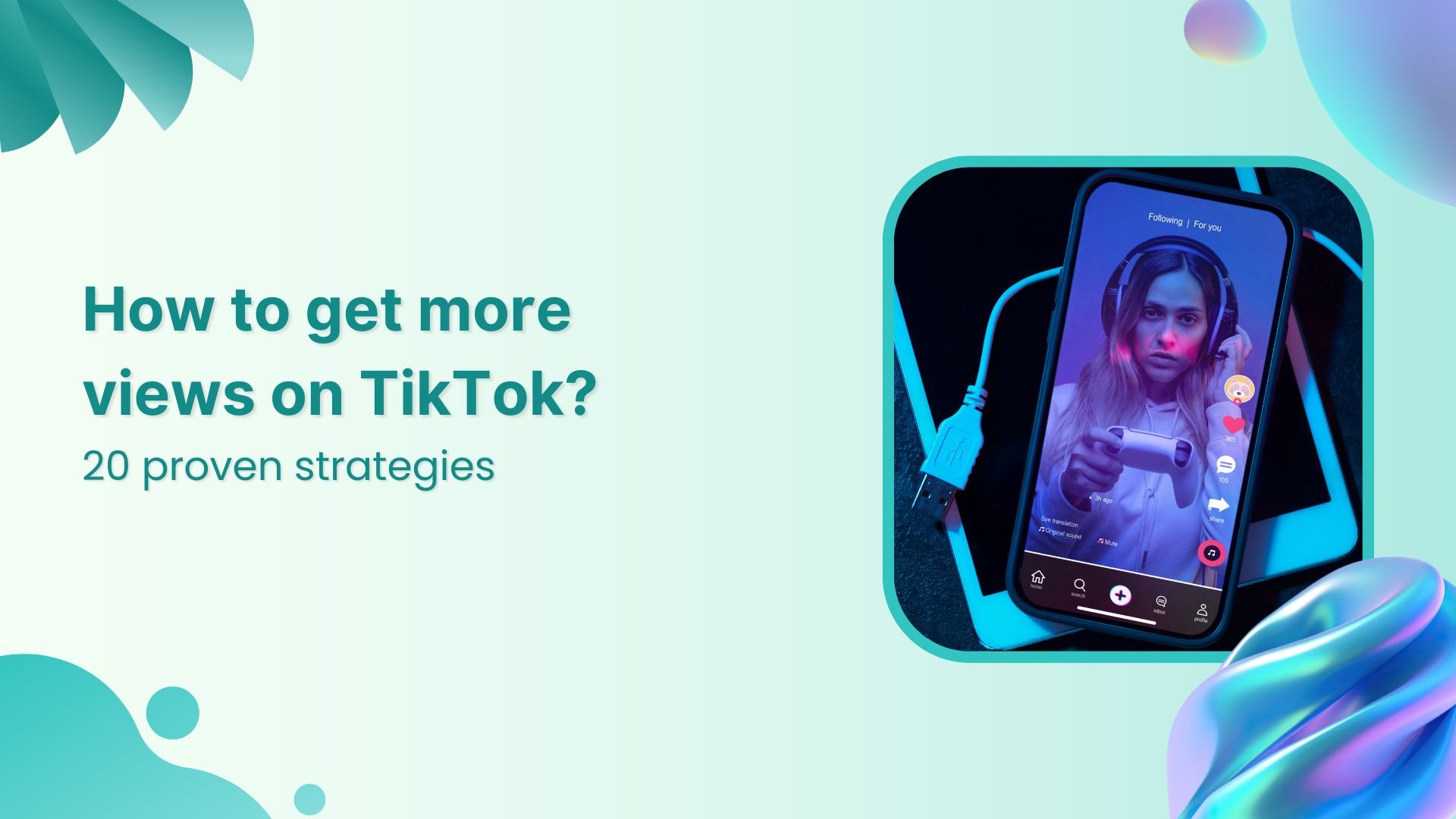Bulk-generate & schedule posts in seconds with Smart Scheduling. Try now!
The ultimate guide to Pinterest Trends to drive traffic
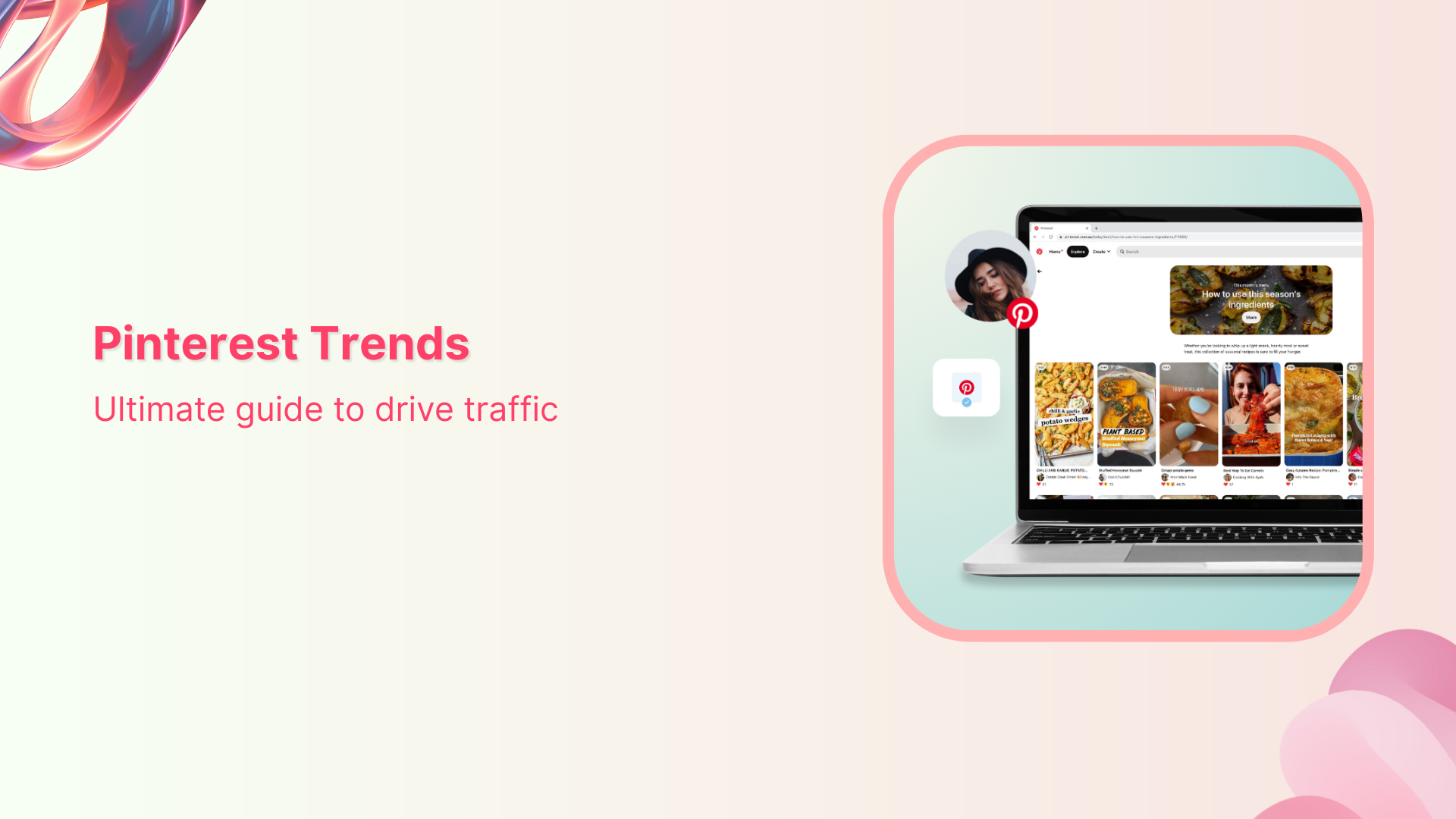
Pinterest isn’t just another social media platform; it’s a visual discovery engine where over 553 million monthly active users find inspiration for everything from home décor to holiday planning, fashion, and recipes. Understanding how to make the most of Pinterest trends can dramatically change your content strategy and drive significant traffic to your website.
Understanding Pinterest Trends and how they work
Unlike fleeting trends on platforms like Twitter or TikTok, Pinterest trends have a unique lifecycle. Trends on Pinterest often emerge 2-3 months before they become popular elsewhere, giving savvy marketers a significant advantage. The platform’s Trends Tool showcases emerging topics and search terms that are gaining momentum, allowing you to anticipate what your audience will be interested in before they even know it themselves. Pinterest’s algorithm identifies trends based on
- Search volume increases
- Saved pins (when users bookmark content to their boards)
- Engagement metrics.
These trends aren’t random—they follow seasonal patterns and reflect genuine user interest, making them highly valuable for content planning.
Why Pinterest stands out among social platforms
Pinterest offers several distinct advantages over other social media platforms:
- Longevity: While Instagram or Facebook posts may disappear from feeds within hours, Pinterest pins continue driving traffic for months or even years.
- Purchase Intent: Pinterest users are actively looking for ideas and products, with 85% of users saying they use the platform to plan new projects.
- Search-Based Discovery: Pinterest functions more like a visual search engine than a traditional social network, meaning your content can reach users who aren’t already following you.
- Positive Environment: The platform maintains a more positive, aspirational atmosphere compared to other social media, creating a better context for brand messaging.
The importance of Pinterest for your business
Integrating Pinterest into your content strategy isn’t just about diversifying your social media presence; it’s about tapping into a powerful traffic and conversion engine.
- Website Traffic: Pinterest is the second-largest source of social media traffic to websites.
- Purchase Decisions: 80% of weekly Pinterest users have discovered new brands or products on the platform.
- Higher Average Order Value: Pinterest users typically spend 40% more monthly than non-users.
- Long-Term ROI: Due to the evergreen nature of pins, your content investment continues delivering value long after publication.
For businesses in visually driven industries like fashion, home décor, food, travel, and DIY, Pinterest isn’t optional—it’s essential. However, even B2B companies are finding success by sharing infographics, quotes, and educational content that resonates with professional audiences.
Social Media Analytics
Fine-tune your social media strategy for success with in-depth analytics and white-labeled reports.
Get Started for FREE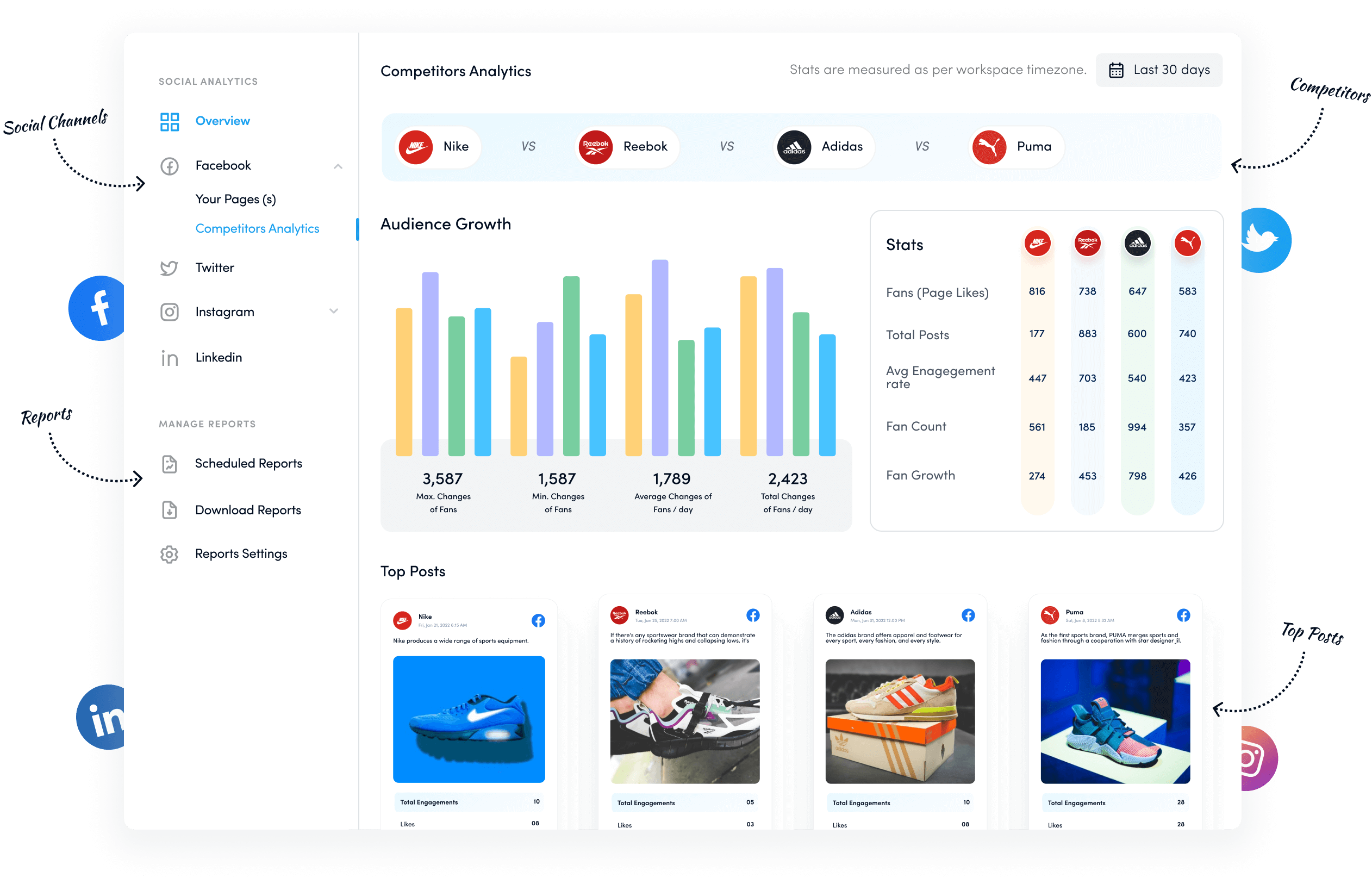
Navigating Pinterest’s trend tools
Pinterest offers several built-in tools to help you identify and leverage trends effectively. Let’s explore how to use these resources to inform your content strategy.
Pinterest Trends Tool
The Pinterest Trends tool is your first stop for trend research. The free resource shows you what’s popular on the platform and how search interests evolve over time.
How to use it effectively:
- Compare up to four search terms to see which are generating more interest
- Identify seasonal patterns to plan content ahead of crucial periods
- Discover related terms that might inspire additional content ideas
The tool displays data in an intuitive graph format, making it easy to visualize when trends peak and how they compare to one another.
Trend Alerts and Reports
Pinterest regularly publishes trend reports, including:
- Annual Pinterest Predicts Report: Released toward the end of each year, this report forecasts trends for the upcoming year based on search data analysis.
- Seasonal Trend Reports: These focus on major shopping and planning seasons like back-to-school, holidays, and summer.
- Category-Specific Insights: Pinterest occasionally releases deeper dives into specific categories like fashion, home, or food.
Following the Pinterest Business blog and subscribing to their newsletter ensures you never miss these valuable resources.

Using Pinterest to search for trend research
Beyond official tools, Pinterest’s search functionality itself reveals trending topics:
- Autocomplete suggestions: When you type in the search bar, Pinterest suggests popular search terms.
- Related searches: After searching, Pinterest displays associated terms at the top of the results.
- Guided search categories: The filtering options after a search help identify specific niches within broader trends.
These features provide real-time insight into what Pinterest users are actively searching for.
Related: Guide to Pinterest analytics: Understanding your performance metrics
Why your brand should pay attention to Pinterest trends
The online world changes constantly, and keeping up with trends helps your brand stay relevant and grow. Pinterest trends specifically provide opportunities you won’t find on other platforms.
Benefits for brand visibility and recognition
Pinterest trends can dramatically amplify your brand’s visibility in ways traditional marketing cannot:
- Early adopter advantage: Brands that capitalize on emerging Pinterest trends often gain first-mover advantage, establishing authority in specific niches before competitors catch on.
- Algorithm favorability: Pinterest’s algorithm rewards content that aligns with rising trends, giving trend-savvy brands increased visibility in search results and home feeds.
- Organic discovery: When your content connects with trending topics, it appears in trend collections curated by Pinterest, exposing your brand to entirely new audiences without additional ad spend.
- Perception positioning: Consistently creating trend-relevant content positions your brand as innovative and in-tune with consumer desires, enhancing brand perception.
Example: When sustainable packaging became a rising Pinterest trend, eco-conscious beauty brand Lush created a series of pins showcasing its package-free products. The content received 3x its normal engagement rate and introduced the brand to sustainability-focused audiences who hadn’t previously encountered it.
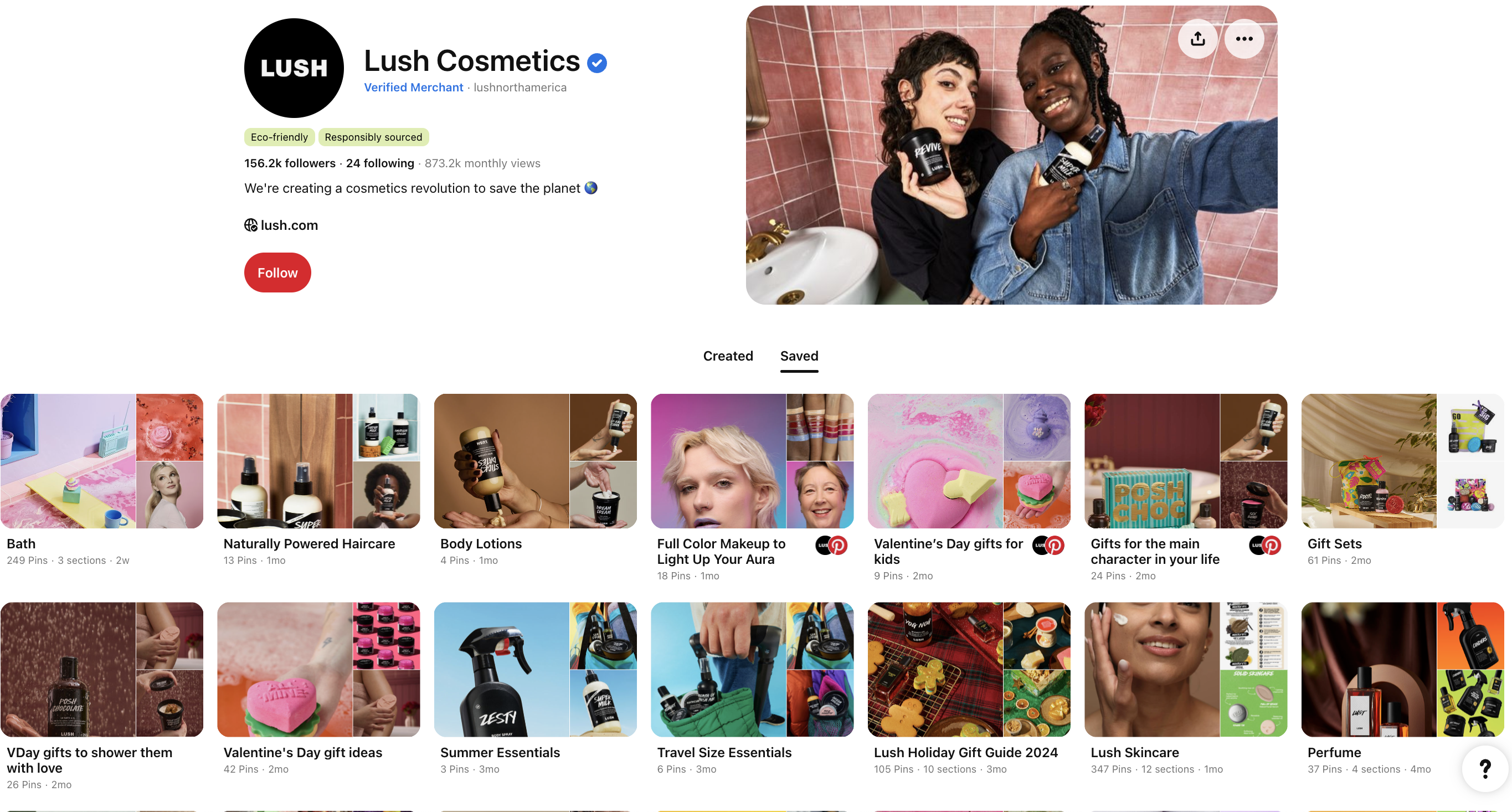
Connecting with ready-to-buy audiences
Unlike some social platforms where users scroll passively, Pinterest users often have clear purchasing intent:
- Purchase planning stage: 97% of Pinterest searches are unbranded, meaning users are actively looking for solutions rather than specific companies—perfect for brands to intercept the buyer journey early.
- Inspiration-to-purchase pipeline: Pinterest users are 80% more likely to purchase products discovered through the platform than through other social media.
- Higher conversion value: >25% of time on Pinterest is spent shopping—higher than on any social media platform
- Extended decision cycles: For high-consideration purchases like furniture or travel, Pinterest users start searching 2-3 months before making decisions, giving brands ample time to nurture leads.
Real-world impact: Home décor brand West Elm regularly aligns their Pinterest content with trending interior design styles. By creating boards dedicated to emerging trends like “Japandi” (Japanese-Scandinavian fusion) before the style went mainstream, they positioned their products as must-haves for trend-conscious decorators, driving a 35% increase in website visits from Pinterest.
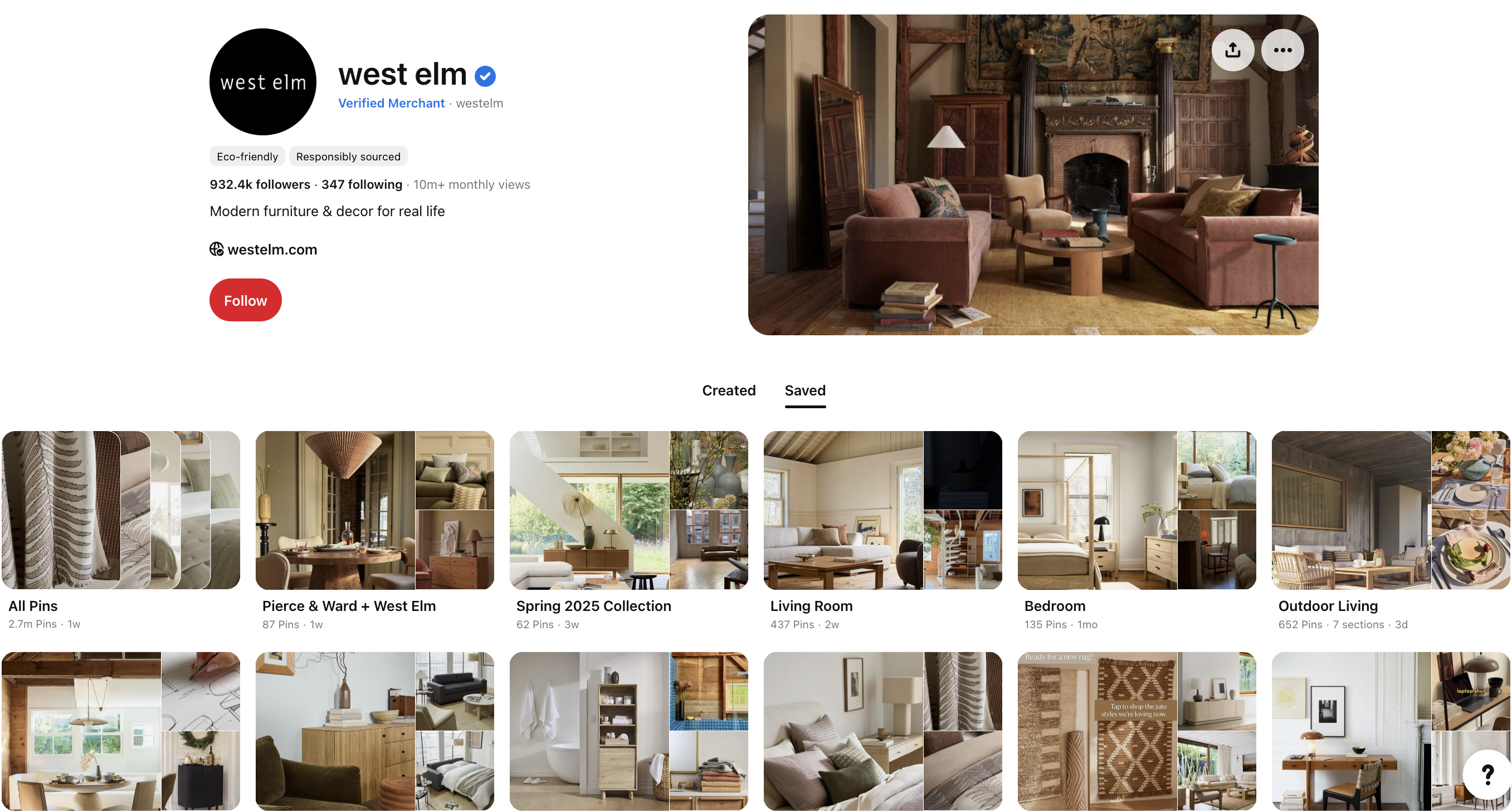
Aligning content strategy with Consumer interests
The most powerful aspect of Pinterest trends is how they reveal genuine consumer interests before they manifest elsewhere:
- Predictive insights: Pinterest trends often precede mainstream adoption by 3-6 months, giving brands valuable forecasting data.
- Seasonal Planning Edge: By analyzing year-over-year trend data, you can anticipate exactly when interest in seasonal topics will peak, optimizing your content calendar accordingly.
- Content Gap Identification: Trending searches with limited existing content represent golden opportunities to create resources that fill consumer needs.
- Product Development Guidance: For product-based businesses, Pinterest trends can inform new product development, ensuring alignment with emerging consumer preferences.
Practical application: A recipe blog noticed “air fryer dinner recipes” trending on Pinterest months before air fryer searches peaked on Google. By creating a comprehensive series of air fryer dinner pins and accompanying blog posts, they secured top positions in both Pinterest and Google search results, resulting in a 215% traffic increase when mainstream interest eventually surged.
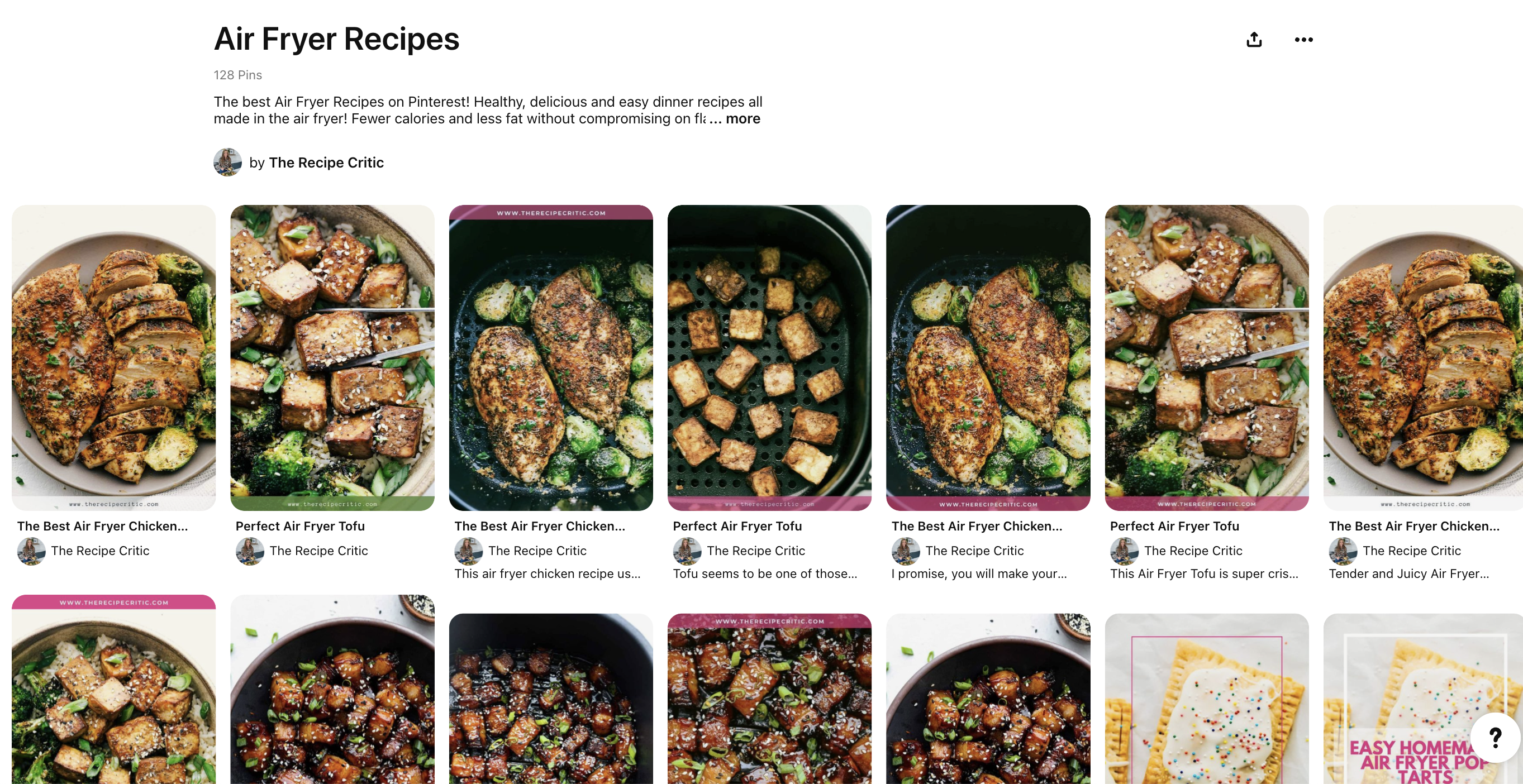
Key Pinterest trends for 2025
As we move through 2025, several distinctive trends are dominating Pinterest searches and saves. Staying ahead of these trends can give your content strategy a significant advantage.
Sustainable living reimagined
Sustainability has evolved from a niche interest to a mainstream concern on Pinterest. In 2025, we’re seeing specific trends within this broader category:
- Circular fashion: Searches for “upcycled clothing ideas” have increased 132% year-over-year, with users seeking creative ways to transform old garments.
- Low-waste home solutions: Terms like “zero-waste kitchen storage” and “plastic-free bathroom” are trending, showing Pinterest users are looking to reduce household waste.
- Climate-friendly cooking: Plant-based recipes and low-carbon footprint meals are seeing massive growth, with “planet-friendly recipes” searches up 89%.
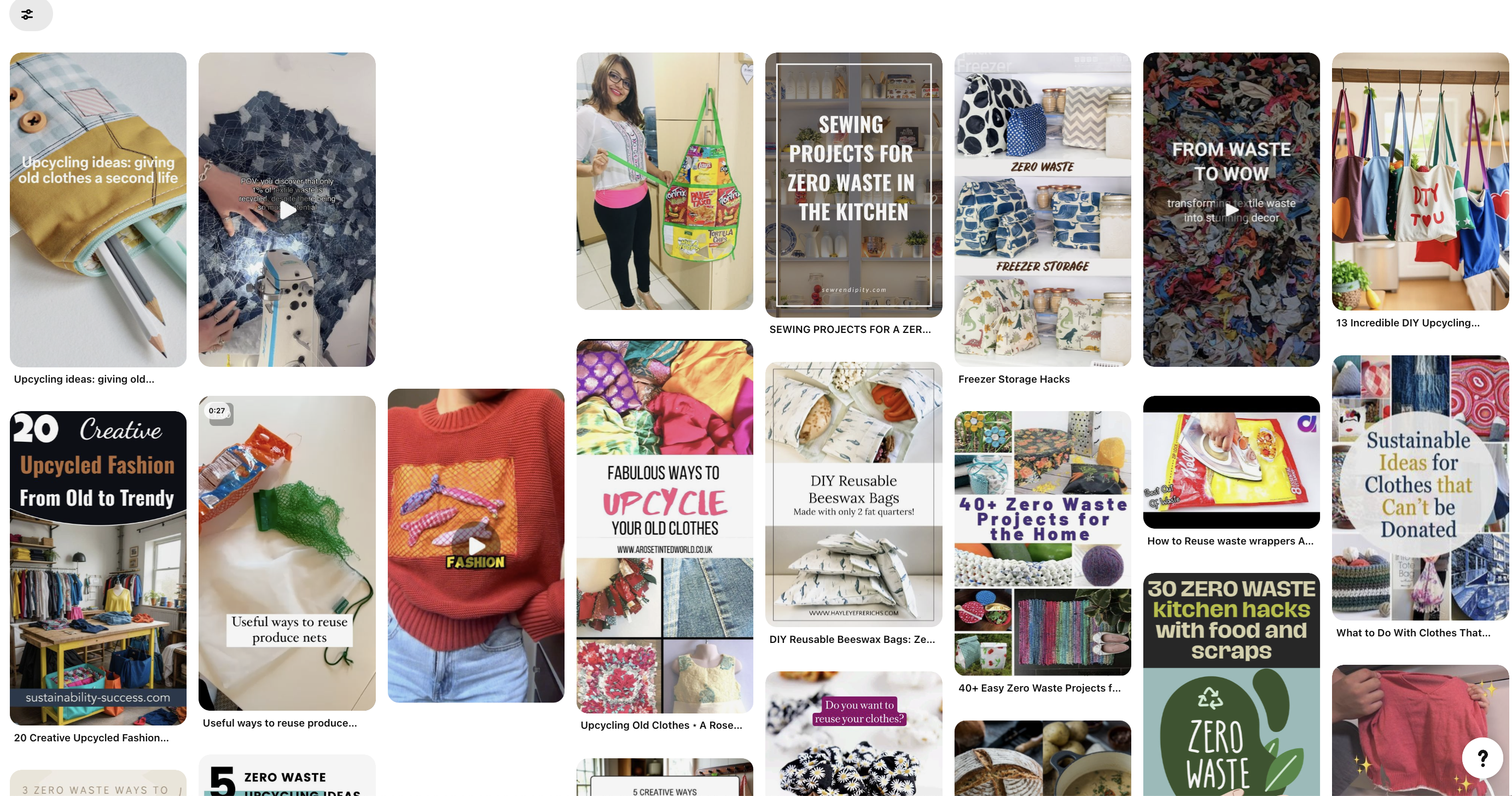
This trend presents opportunities for fashion, home goods, and food brands to showcase their sustainable practices and products. For example, create pins featuring your product’s eco-friendly packaging or demonstrate how your clothing can be styled in multiple ways for maximum wardrobe longevity.
Tech-life balance
As digital saturation continues, Pinterest users are increasingly searching for ways to maintain a healthy relationship with technology:
- Digital detox spaces: Home design searches for “tech-free zones” and “screen-free bedroom” have risen dramatically.
- Analog hobbies: Crafts and activities that don’t involve screens are trending, with searches for “paper crafting for adults” and “traditional board games” seeing significant growth.
- Mindful tech usage: Content about “healthy screen time habits” and “productivity without burnout” is resonating with users.
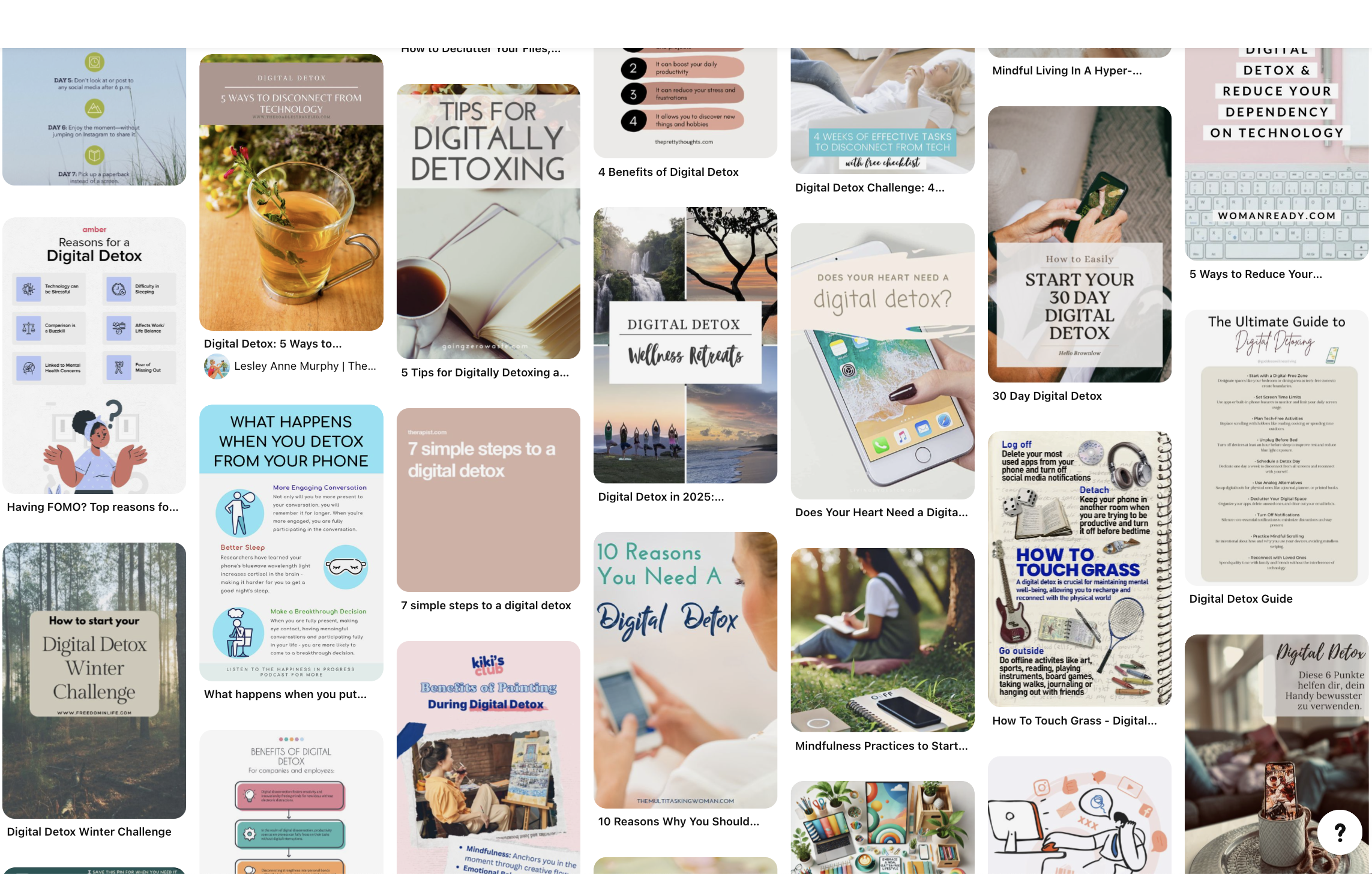
Content creators can leverage this trend by developing pins that show how your products or services help people disconnect. A furniture brand might showcase reading nooks or conversation areas designed without television as the focal point, while wellness bloggers could create content about activities that don’t require devices.
Hyper-personalized wellness
Health and wellness remain Pinterest mainstays, but 2025 is bringing a shift toward individually tailored approaches:
- Genetic wellness: Content about how genetics influence exercise needs or nutrition requirements is trending upward.
- Personalized fitness plans: “Workout for my body type” and “exercise for my age” searches show users seeking customized approaches.
- Mental health customization: Interest in “anxiety techniques for my personality type” and similar personalized mental wellness content is growing rapidly.
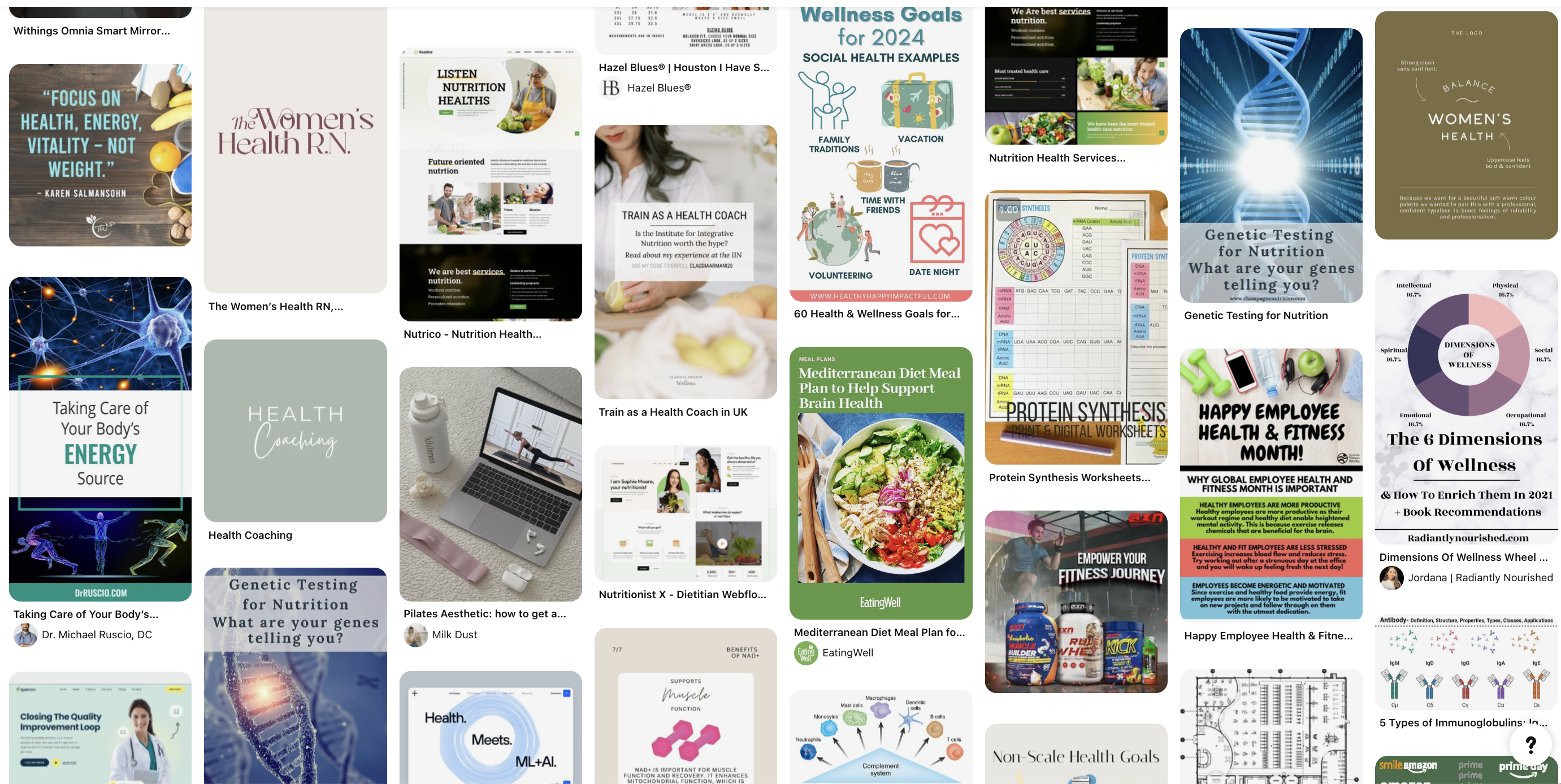
This trend offers opportunities for health, fitness, and wellness brands to create more nuanced content that acknowledges individual differences rather than one-size-fits-all solutions. Consider creating multiple versions of your wellness pins tailored to different personas or needs.
Immersive home environments
Pinterest has always been a hub for home inspiration, but 2025 brings a focus on creating spaces that engage multiple senses:
- Textural interiors: Searches for “tactile wall coverings” and “mixed texture living room” point toa desire for homes that offer tactile interest.
- Scent zoning: Content about “fragrance mapping for homes” and “room-specific essential oil blends” shows a growing interest in using scent intentionally.
- Sound-designed spaces: Pins about “acoustic improvement home” and “sound bathing rooms” reveal attention to the auditory environment.

Home décor brands, interior designers, and DIY bloggers can capitalize on this trend by creating content that addresses multiple sensory experiences. Show how products look and feel when they are in use or develop guides for crafting fully immersive spaces.
Micro escapism
While travel content remains popular, 2025 Pinterest trends show users looking for escape in smaller, more accessible ways:
- Backyard transformations: Searches for “vacation-inspired backyard” and “resort patio at home” have increased substantially.
- Transportive cooking: Recipe pins focusing on regional flavors with titles like “Taste of Tuscany dinner” or “Tokyo street food at home” are highly engaged.
- Destination-inspired décor: Interest in rooms styled after specific locations, such as a “Mediterranean bathroom design” or a “Scandinavian reading corner,” continues to climb.
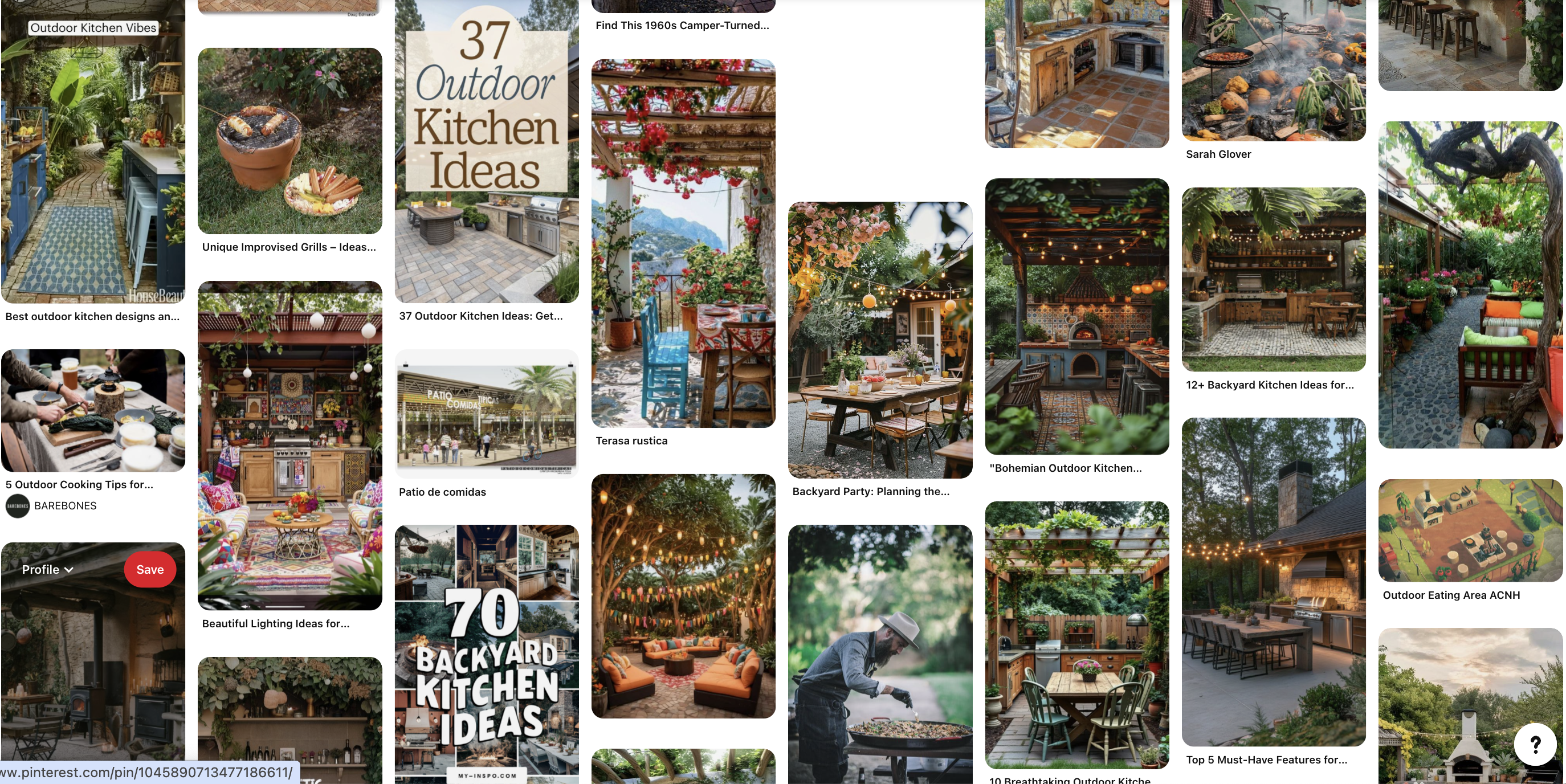
This trend provides travel, food, home décor, and garden brands opportunities to show how their products can create transportive experiences without requiring major trips. Travel bloggers might pivot to creating content about bringing global experiences home.
Planning your content calendar with Pinterest trends
Success on Pinterest requires both strategy and timing. You can maximize visibility and engagement throughout the year by aligning your content calendar with Pinterest trends.
Timing your content for maximum impact
Pinterest users typically begin searching for ideas weeks or months before they make decisions or purchases, creating a unique planning timeline:
- Seasonal content preparation: Post Valentine’s Day content in December, summer content in March, and holiday content in September to capture early planners.
- Day-of-week optimization: Schedule weekend pins (especially Saturday morning) when engagement peaks for most niches.
- Time-of-day strategy: The best posting times vary by industry, but generally, 8-11pm and 2-4pm EST see high engagement levels.
- Trend lifecycle awareness: Most Pinterest trends follow a bell curve—aim to publish when a trend is gaining momentum rather than after it peaks.
Pro tip: Create a Pinterest-specific editorial calendar that runs 2-3 months ahead of your regular content calendar. When you notice a trend emerging in Pinterest’s trend tools, schedule related content for 2-4 weeks later on your website, then immediately create and schedule pins to capture early interest.
Balancing trending and evergreen content
While trend-focused content can drive short-term traffic spikes, a sustainable Pinterest strategy requires balance:
- 60/40 approach: Aim for approximately 60% evergreen content and 40% trend-based content in your Pinterest strategy.
- Trend-evergreen fusion: Whenever possible, create content that incorporates trending elements into evergreen topics (e.g., “10 Timeless Kitchen Designs with 2025’s Trending Color Palette”).
- Trend testing: Use trending content to test audience response before developing more extensive evergreen resources on the same topic.
- Repurposing strategy: Update existing evergreen pins with trending elements—new colors, fonts, or keywords—to give them fresh relevance.
Example: A fitness blogger maintains boards for fundamental topics like “Healthy Meal Prep” and “Home Workouts” (evergreen) while regularly creating new content around trends like “Metabolic Workouts” or “Anti-inflammatory Recipes” as they gain popularity.
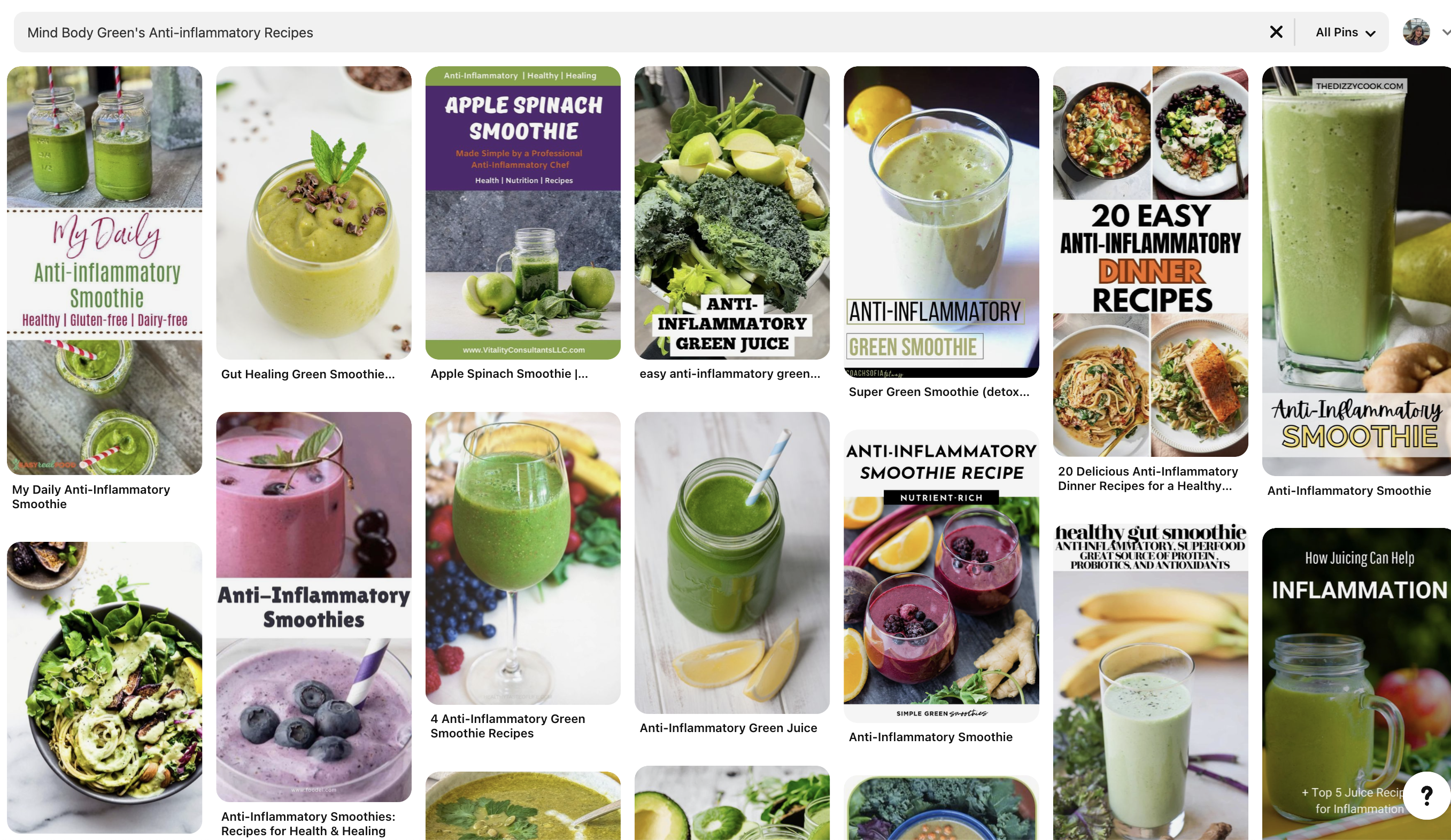
Using Pinterest trends for better content creation
Beyond timing, understanding how to leverage Pinterest’s trend tools and insights can significantly boost your content quality and relevance.
Utilizing Pinterest’s built-in trend tools
Pinterest offers several native tools to help creators stay ahead of emerging trends:
Pinterest trends dashboard features
The Pinterest Trends dashboard (pinterest.com/trends) offers valuable features for content planning:
- Search volume graphs: Visualize interest over time to identify when trends are building momentum.
- Related terms: Discover adjacent topics and variations that might align better with your brand.
- Geographic insights: See where trends are most popular to target content geographically if relevant.
- Demographic breakdown: Understand which age groups and genders are driving specific trends.
Use the comparison feature to assess up to four related terms simultaneously, helping you choose the most promising trend variation for your content focus.
Finding the right trending topics for your niche
Not every trend will align with your brand or audience. Use these strategies to identify relevant opportunities:
- Relevance filtering: Consider trends through your brand’s value proposition and expertise lens—only pursue those where you can add genuine value.
- Audience alignment: Focus on trends that overlap with your existing audience demographics and interests.
- Competitor trend gap analysis: Identify popular trends your competitors haven’t yet addressed.
- Trend adaptation: When a broad trend doesn’t quite fit, look for ways to adapt it to your niche (e.g., a sustainable fashion brand might adapt “maximalist décor” trends to “sustainable maximalism in fashion”).
Case study: A pet supply company noticed the broader “at-home spa day” tren, but instead of ignoring it as irrelevant, they created content around “Pet Spa Day at Home,” which became one of their most successful Pinterest campaigns.
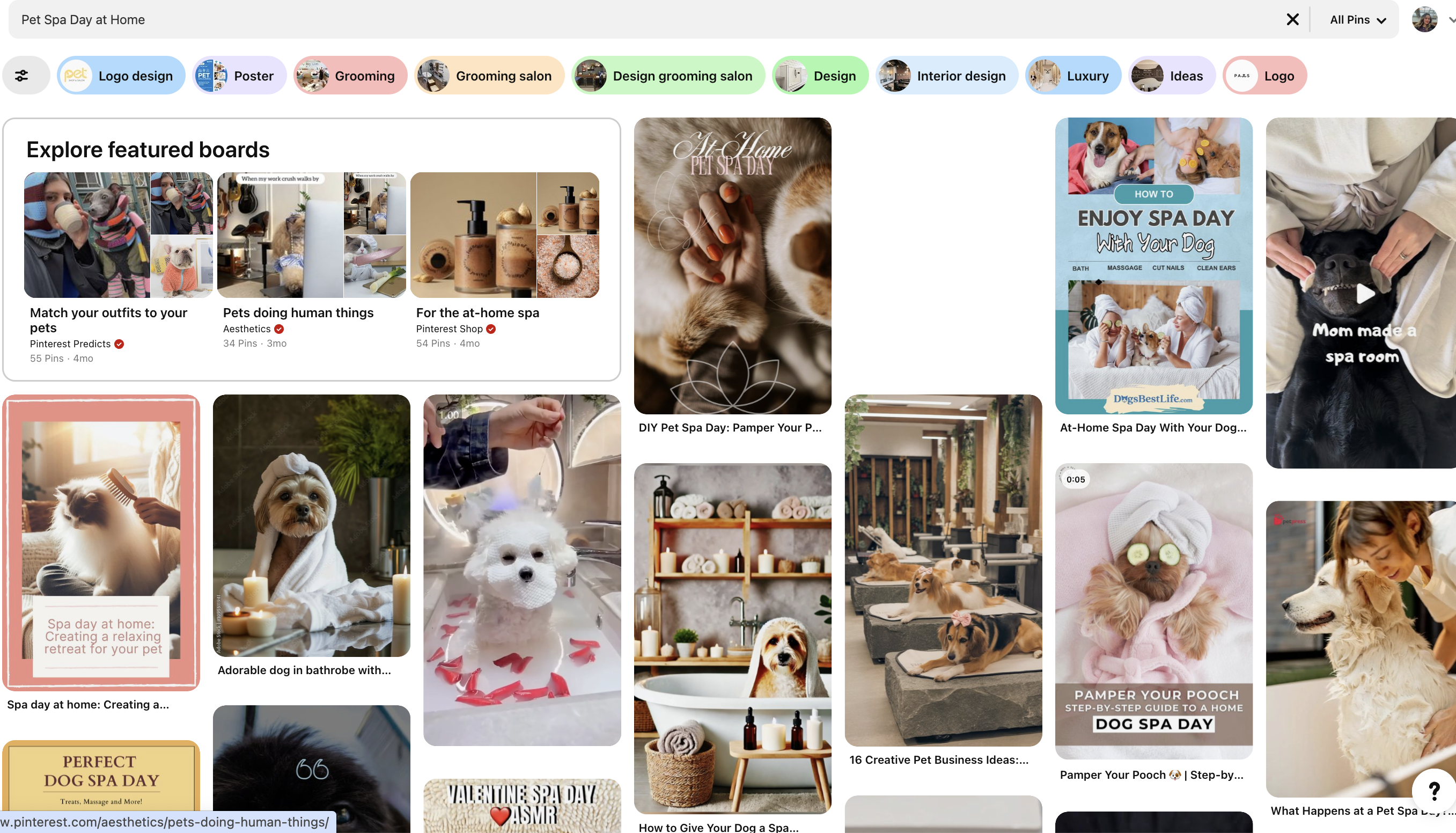
Identifying popular keywords and search terms
Effective trend utilization requires understanding the specific language Pinterest users employ:
- Keyword variation testing: Try different versions of similar terms in the trend tool to find the most popular phrasing (e.g., “low-waste kitchen” vs. “zero-waste kitchen”).
- Long-tail trend terms: Look beyond broad trend categories to specific long-tail searches that have less competition (e.g., “morning yoga for back pain” rather than just “yoga trends”).
- Question-based searches: Identify trending questions in your niche using Pinterest autocomplete (start typing “how to…” or “why does…” and note the suggestions).
- Image search terms: Use Pinterest Lens (camera search) on related products or images to discover how users search for similar visual content.
Action step: Create a running list of trending keywords in your niche, updated monthly, and incorporate these terms naturally into new pin descriptions, board titles, and image text overlays.
Discover what’s trending with pinterest’s seasonal insights for 2025
Pinterest has released its Pinterest Predicts 2025 report showing upcoming trends in fashion, home decor, beauty, and lifestyle. Based on actual search and save data, this report helps creators and marketers plan content before trends go mainstream.
What’s included this year:
- Trend Forecasting by Category: New aesthetics like Sea Witchery and Fisherman Aesthetic are gaining momentum across home decor and fashion categories.
- The 2025 Pinterest Palette: Five colors to watch—Cherry Red, Butter Yellow, Aura Indigo, Dill Green, and Alpine Oat—predicted to appear throughout design and content this year.
- Seasonal Strategy Insights: Practical recommendations for when to launch campaigns aligned with seasonal interests, helping you time content more effectively.
Pinterest Predicts 2025 gives you a head start on trends rather than catching up to them, making it useful for planning content, campaigns, and design work.
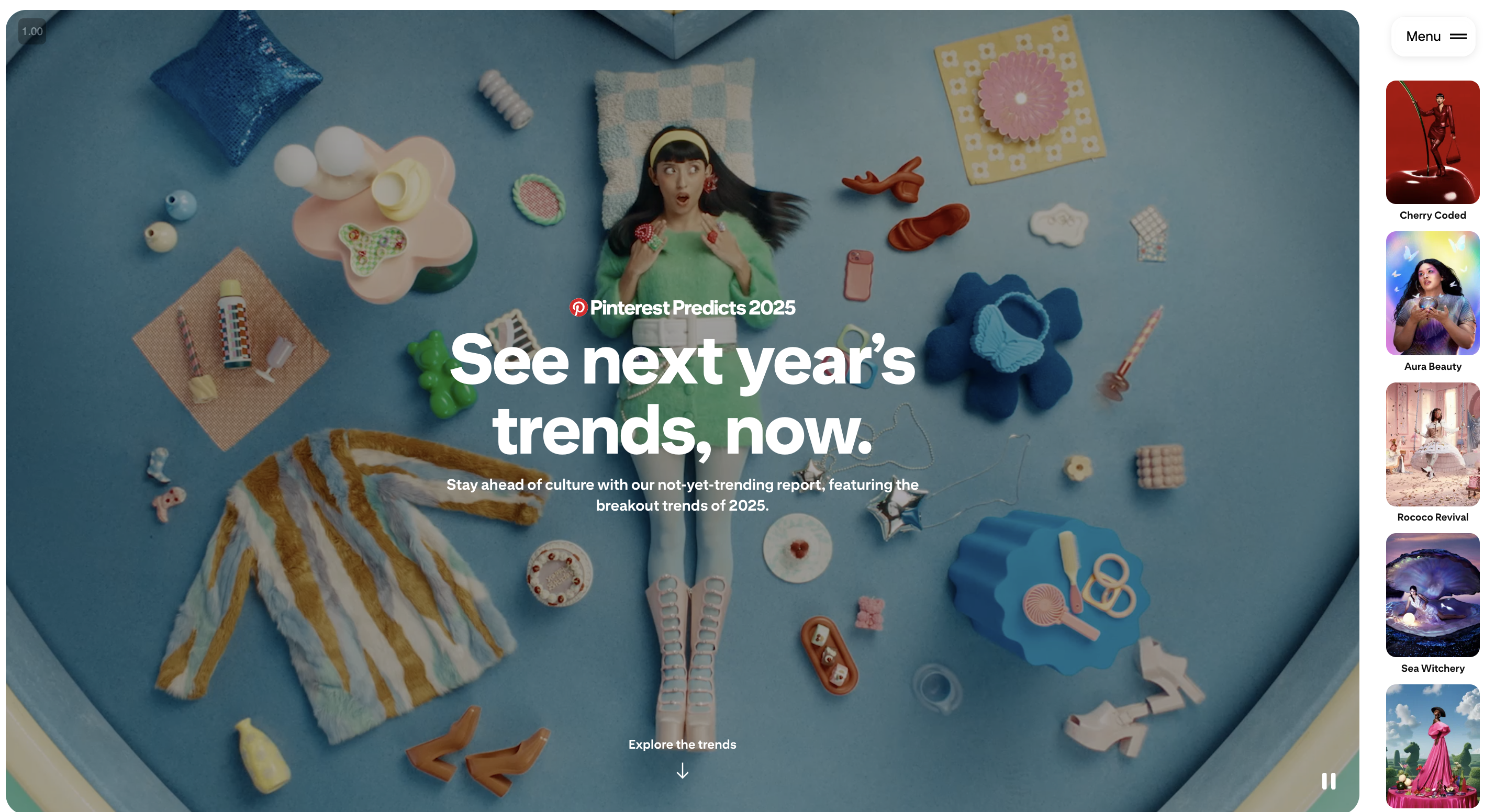
Maximizing your Pinterest strategy with ContentStudio
When managing Pinterest for business, having the right tools can make a significant difference. ContentStudio offers features specifically designed to enhance your Pinterest marketing efforts and streamline your workflow.
Streamlining content scheduling and publishing
ContentStudio simplifies the process of maintaining a consistent Pinterest presence:
- Bulk upload capability: Create and schedule multiple pins at once rather than posting them individually.
- Cross-platform coordination: Align your Pinterest content with posts on other social platforms for cohesive campaigns.
- Content calendar visualization: See your scheduled Pinterest content alongside other marketing activities for better planning.
- Queue scheduling: Set up custom posting schedules based on when your audience is most active on Pinterest.
- Content recycling: Automatically republish your best-performing pins to extend their reach without manual work.
With these features, you can maintain an active Pinterest presence even during busy periods, ensuring you’re consistently showing up for your audience.
Pinterest analytics made easy with ContentStudio
Beyond scheduling, ContentStudio provides valuable insights into your Pinterest performance.
Understanding key performance metrics
ContentStudio’s analytics dashboard highlights the most important Pinterest metrics:
- Pin performance tracking: See which pins generate the most impressions, saves, and clicks.
- Traffic analysis: Monitor how much website traffic comes from different pins and boards.
- Audience insights: Learn when your audience is most active and which content types they engage with most.
- Growth trends: Track follower growth and engagement rates over time to measure account progress.
- Content type comparison: Determine whether standard, video, or carousel pins perform best for your specific audience.
These insights help you make data-driven decisions about your Pinterest strategy rather than guessing what works.
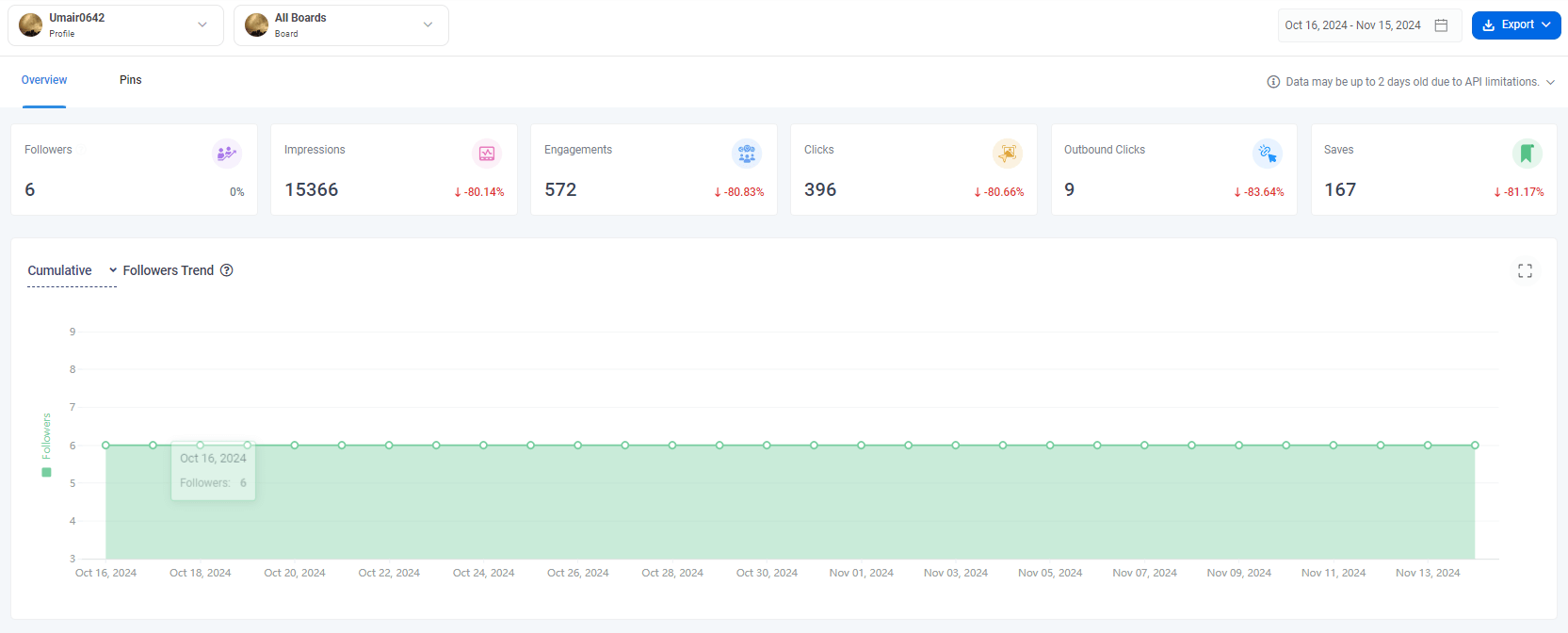
Creating reports for clients or teams
For agencies and marketing teams, ContentStudio simplifies the reporting process:
- Customizable reports: Select which metrics to highlight based on what matters most to your clients or team.
- Visual data representation: Present complex metrics in easy-to-understand charts and graphs.
- Performance comparisons: Show how current results compare to previous periods to demonstrate progress.
- Export options: Download reports in multiple formats for presentations or record-keeping.
Clear, consistent reporting builds confidence in your Pinterest strategy and helps justify marketing investments with tangible results.
Integrating ContentStudio into your Pinterest workflow allows you to save time on routine tasks while gaining deeper insights into what works. This allows you to focus more energy on creating trend-aligned content that resonates with your audience and drives meaningful results.
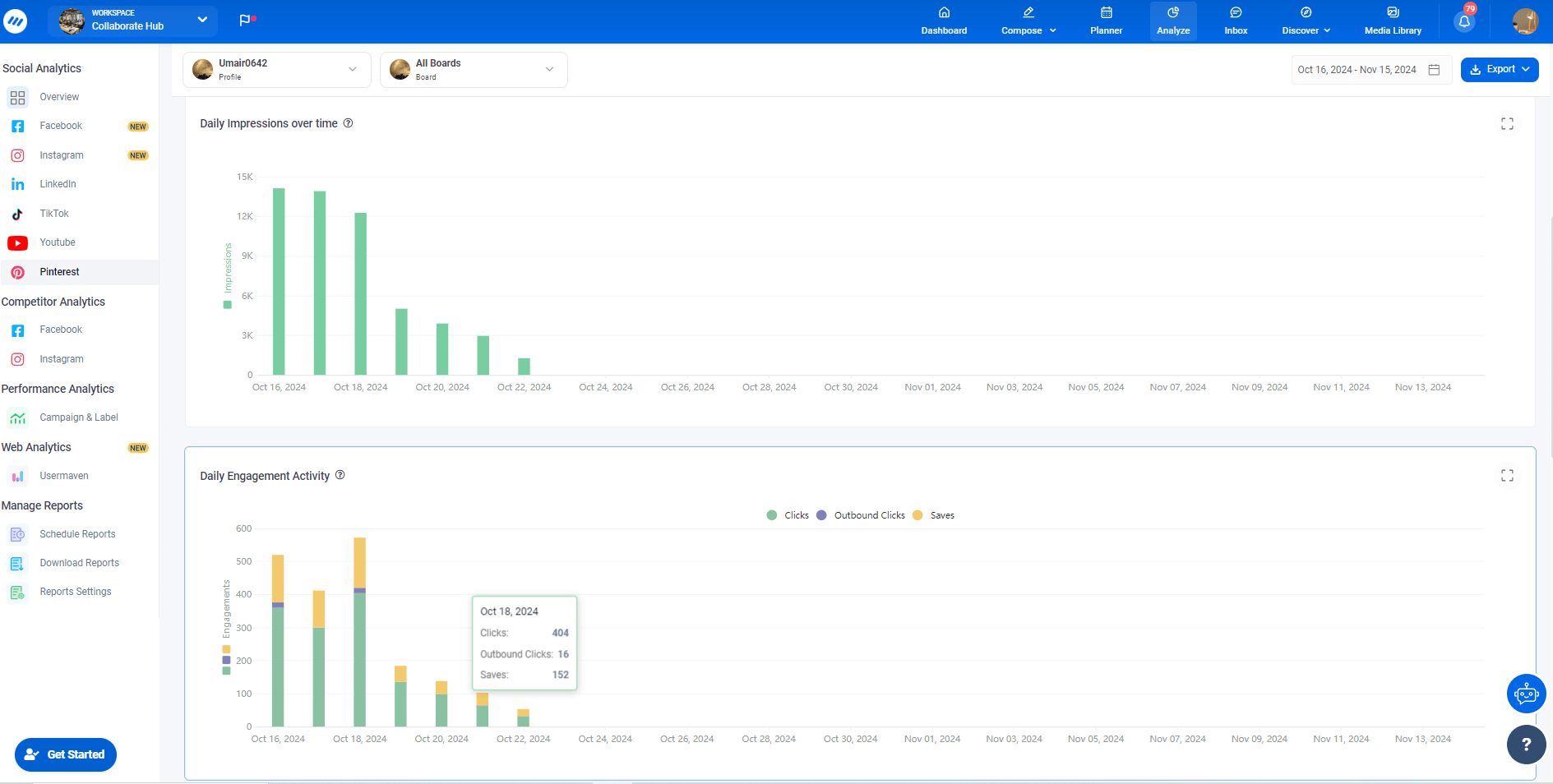
Avoid these common Pinterest trend mistakes
While following trends can boost your Pinterest presence, inevitable missteps can undermine your efforts. Here are key mistakes to avoid:
Neglecting your core audience preferences
Even the hottest trend won’t deliver results if it doesn’t resonate with your specific audience:
- Audience-trend mismatch: Not every trending topic will appeal to your followers, regardless of its popularity on the platform overall.
- Demographic blind spots: Some trends are age, gender, or region-specific. A trend popular with Gen Z might fall flat with your millennial audience.
- Value misalignment: Trends that conflict with your audience’s core values can damage engagement and trust.
- Conversion disconnect: Trends that attract views but don’t align with purchase intent won’t drive meaningful business results.
Always filter trends through the lens of your audience’s demonstrated preferences. Check your Pinterest analytics to understand which past content has performed well before jumping on new trends.
Overusing or misusing trending topics
Trends can lose their effectiveness when improperly executed:
- Trend saturation: Flooding your profile with the same trending topic creates content fatigue.
- Surface-level implementation: Simply tagging content with trending keywords without meaningful integration feels inauthentic.
- Late adoption: Jumping on trends after they’ve peaked means competing in an already crowded space.
- Poor contextual fit: Forcing trends into irrelevant content contexts confuses your audience and undermines credibility.
For best results, select 2-3 trends per quarter to focus on deeply rather than trying to capitalize on every emerging trend.
Failure to maintain brand authenticity
Perhaps the most damaging mistake is losing your unique brand voice while chasing trends:
- Identity dilution: Constantly shifting visual styles or messaging to match trends weakens brand recognition.
- Expertise abandonment: Veering too far from your core expertise area to follow trends reduces your authority.
- Transparency issues: Claiming expertise in trending areas where you lack genuine knowledge damages trust.
- Values inconsistency: Following trends that contradict previously stated brand values creates cognitive dissonance for followers.
The solution is selective adaptation: modify trends to fit your brand rather than modifying your brand to fit trends. Maintain consistent visual elements, voice, and values while thoughtfully incorporating trending elements.
Proven strategies for Pinterest growth
For those ready to enhance their Pinterest strategy, these proven approaches can drive significant growth.
Cross-promoting your Pinterest content
Pinterest doesn’t exist in isolation—leverage your entire digital ecosystem:
- Email integration: Feature your best Pinterest boards in newsletters with clear calls to follow.
- Website embedding: Embed relevant Pinterest boards directly on your website pages to encourage cross-platform engagement.
- Instagram-to-Pinterest pipeline: Use Instagram Stories to highlight your Pinterest boards with swipe-up links (for eligible accounts).
- Podcast mention strategy: If you produce audio content, verbally direct listeners to specific Pinterest boards for visual companions to episodes.
- YouTube description links: Include links to relevant Pinterest boards in video descriptions for viewers seeking additional inspiration.
Creating this cross-platform ecosystem ensures your Pinterest content reaches your audience wherever they spend time online.
Tracking performance and adapting strategies
Sophisticated Pinterest marketers maintain a constant feedback loop:
- Weekly performance reviews: Set aside time each week to review which pins and boards are gaining traction.
- A/B testing system: Systematically test different image styles, text overlays, and descriptions to identify what drives the best results.
- Trend lifecycle monitoring: Track how long specific trends remain relevant and adjust your content production accordingly.
- Competitor performance analysis: Monitor how similar accounts are performing with trend-based content to identify opportunities and gaps.
- ROI calculation: Move beyond vanity metrics to understand the actual business impact of your Pinterest activity through proper attribution tracking.
The most successful Pinterest marketers in 2025 will balance trend awareness with audience insights, maintaining authentic brand positioning while strategically evolving with the platform. By avoiding common mistakes and implementing advanced growth strategies, you’ll be positioned to capture the full potential of Pinterest for your brand.
Conclusion
When used effectively, Pinterest trends offer a powerful way to boost your content strategy. You can significantly increase your visibility and engagement by understanding trend cycles, utilizing Pinterest’s built-in tools, and aligning trends with your audience’s interests.
Remember these key points:
- Pinterest users often search for inspiration months before making decisions, giving you a valuable early window into consumer interests
- Balance trending content (40%) with evergreen content (60%) for sustainable growth
- Maintain your brand authenticity while adapting trends to fit your unique voice
- Cross-promote your Pinterest content across other platforms to maximize reach
- Track performance metrics consistently and be willing to adjust your approach based on results
Begin implementing these strategies today, and watch as your Pinterest presence evolves from just another social media profile to a powerful driver of traffic, engagement, and brand awareness.
FAQ’s
Use the Pinterest Trends tool (trends.pinterest.com), notice autocomplete suggestions when searching, review the annual Pinterest Predicts report, explore trending categories on your home feed, check the “Popular” section in search results, and follow the Pinterest Business Blog for industry updates.
Create boards on trending topics, use trending keywords in descriptions, develop content aligned with emerging trends, post during early growth phases, maintain brand identity while incorporating trends, share across other platforms, and monitor metrics to refine your approach.
Pinterest trends are gaining popularity on the platform, identified through increased searches and saves. They emerge 2-3 months before mainstream adoption, develop within specific categories like home or fashion, feature strong visual elements, predict future purchasing behavior, and last longer than trends on other social platforms.
Recommended for you

Reputation management strategy in 2026: What every business needs to know
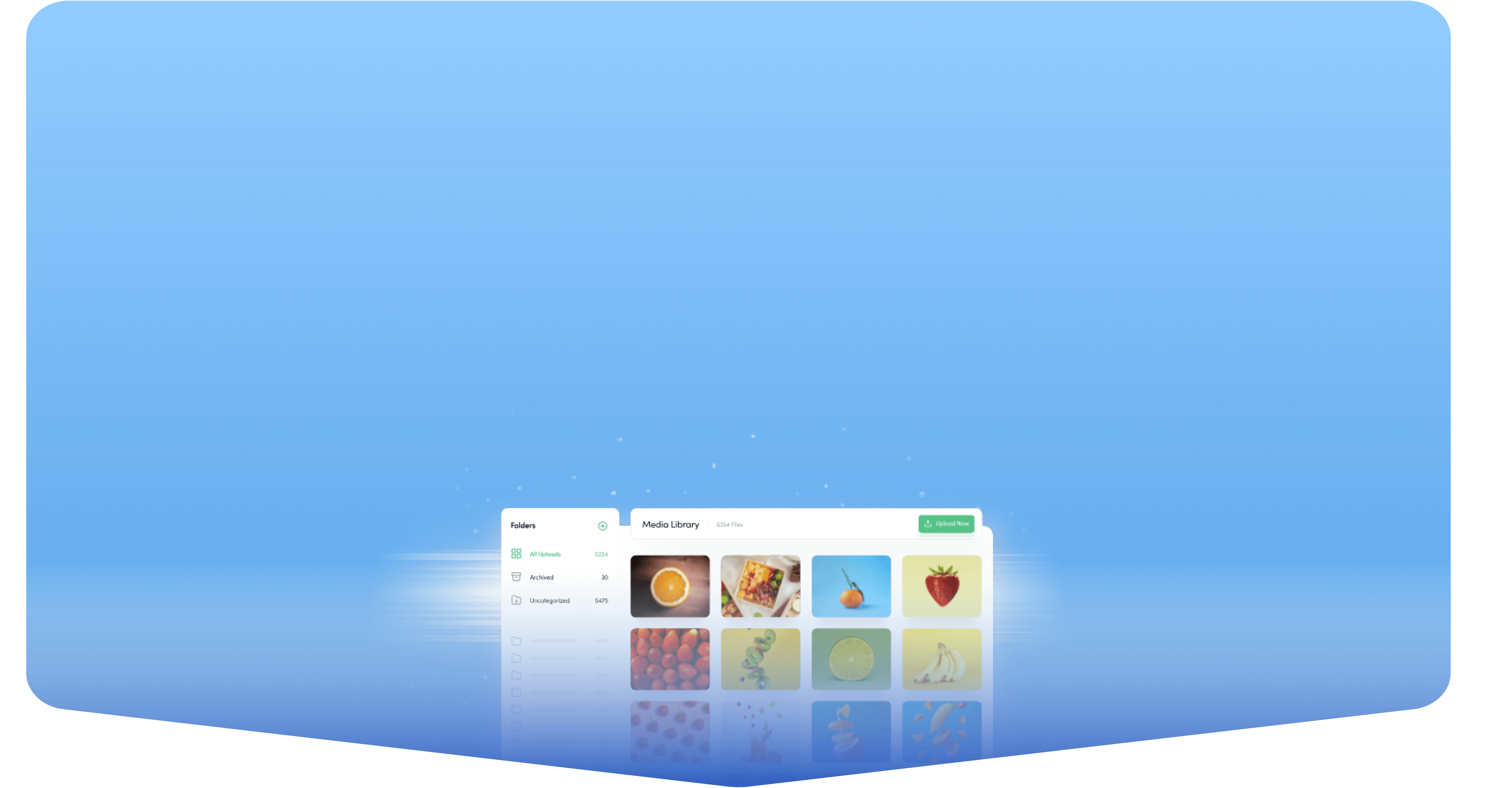

Powerful social media management software
14-day free trial - No credit card required.


